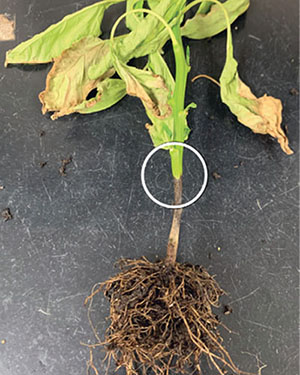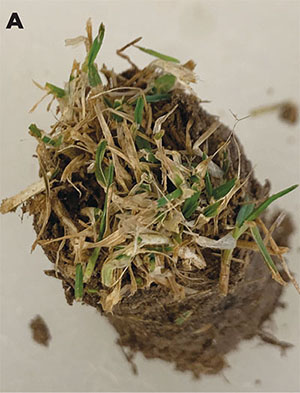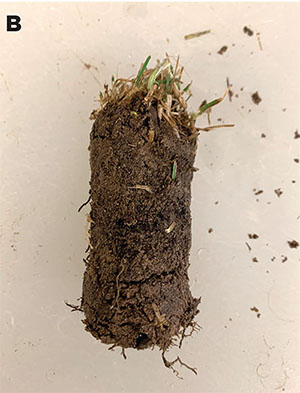Guide H-158
Revised by Phillip Lujan
College of Agricultural, Consumer and Environmental Sciences, New Mexico State University
Program Manager, Department of Extension Plant Sciences, New Mexico State University. (Print Friendly PDF)
Successful plant disease diagnosis is a team effort. Proper diagnosis begins with the submission of a good-quality specimen accompanied by accurate and complete information. It is difficult, if not impossible, to determine the cause of death from a single leaf, dried or old specimen, or (especially) a dead plant. Healthy plants from the same area are also helpful to a diagnostician. It is also important to include the margin of the disease (where healthy and diseased tissue come together) in the sample, especially with stem and branch disorders (Figure 1).
Figure 1 . Example of margin of disease.
Guidelines for Submitting Specimens to the Plant Diagnostic Clinic for Diagnosis
NMSU’s Plant Diagnostic Clinic provides plant diagnostic services for the state of New Mexico. Please read and follow these instructions before submitting specimens. Visit https://aces.nmsu.edu/ces/plantclinic/ for more information. Please read and follow these instructions before submitting specimens.
Collecting
1. Provide as much information regarding the specimen as possible. Fill out a “Plant Specimen Submission Form” (Figure 2).
Figure 2. Plant Specimen Submission Form, available at https://aces.nmsu.edu/ces/plantclinic/documents/nmsu-pdc-form-012-001-plant-specimen-submission-form.pdf
a. Identify the plant material (variety), approximate age of the plant or planting date, and acreage (when applicable), and indicate the number or percentage of plants affected.
b. Describe the symptoms you are seeing on the plant within the field. Be as descriptive as possible. Indicate when the symptoms first started and whether or not the symptoms are continuing to develop or spread on the plant itself or to other nearby plants.
c. List all cultural practices, such as irrigation frequency, rate and time of chemical application (herbicides, insecticides, fungicides, etc.), fertilizer regime, and crop rotation over the previous three years when applicable.
d. Try to give an estimate of the weather conditions preceding and during symptom development.
e. For home or urban plantings, indicate the type of environment in which the plant is growing (e.g., lawn, flower bed, pot, house, greenhouse).
f. Several, good-quality, in-focus photographs or digital images of the plant in its environment can be extremely helpful to the diagnostician. Digital images can be sent via email to: pl11@nmsu.edu
If the images correspond with a submitted sample, please be sure to note that in the email message (Figures 3A–D).
Figures 3A–D: Examples of submitted photos. A, B, and C: Phymatotrichum root rot on alfalfa. D: Iron deficiency in Gerbera sp.
2. Select plant material that shows the symptoms. If possible, it is best to send several samples showing various stages of the problem. Early stages of symptom development are especially important.
3. Send samples of all plant parts whenever possible, including roots. Aboveground symptoms may be caused by root or stem diseases; thus, examining all parts can be essential for an accurate diagnosis. Dig plants (do not pull them) out of the soil. Pulling plants out of the soil will generally break off the roots, especially if they are rotten. Retain a small amount of soil around the roots. Do not wash roots. Keep the roots and soil separate from the aboveground parts of the plant by placing them in a paper bag and sealing them off with a rubber band.
4. When the entire plant cannot be sent, send several affected portions of the plant (Figure 4). Remember to include the margin of disease on stem and branch samples.
Figure 4. Examples of proper sample submissions of leaf spot.
5. If you suspect vascular wilt diseases, such as Verticillium wilt, send a sample from dying branches with wilted yellow leaves. Do not send dead wood. Place several branch sections 1/4 to 1 inch in diameter and approximately 6 inches in length in a plastic bag. This will prevent the sample from drying in transit (Figure 5).
Figure 5. Sample of branch section.
6. Turfgrass samples should be taken from the edge of the affected area and should include both dying and healthy areas. Do not send dead grass. Send several 3 inch × 3 inch squares of sod, which should include at least 2 inches of soil. Wrap the sample in a thin layer of damp (not wet) paper towels, followed by dry newspaper (Figures 6A–B).
Figures 6A–B. Examples of turf submission.
7. Fleshy specimens, such as fruit, mushrooms, or other fungal fruiting bodies, should be as firm as possible and show both early and intermediate symptoms. Wrap specimens separately in dry paper towels or dry newspaper. Do not put in plastic. Pack specimens so they are not crushed during shipping.
Packing
- Keep plants cool and moist prior to shipping. Use an ice chest when collecting samples and then place them in the refrigerator until they can be sent.
- Pack in a sturdy container to prevent crushing during transit. Use newspaper to pack specimens firmly in the container. Be sure to include a completed submission form with your contact information, including email address or phone number.
- Mail specimens as soon as possible after collection (overnight delivery is recommended). Mail early in the week to avoid delivery delays over weekends, and be aware of holidays that also might delay delivery.
Address packages to:
Plant Diagnostic Clinic
Extension Plant Sciences, MSC 3AE
New Mexico State University
P.O. Box 30003
Las Cruces, NM 88003–8003
For overnight, UPS, or Fed Ex:
New Mexico State University
Plant Diagnostic Clinic
945 College Avenue
Skeen Hall Room N140
Las Cruces, NM 88003–8003
The diagnosis and report you receive is only as good as the sample you send. In some cases, diagnoses may require the use of tests or equipment that are not available at our facility. In those cases, commercial laboratories may be recommended. While time devoted to individual samples is limited, diagnostic reports will reflect considered opinion and best judgment based on all the information available. Complete information regarding the sample that is submitted will help the diagnostician provide an accurate diagnosis. For some problems, such as insect damage, other professionals/specialists may be consulted. Specimens may be forwarded to scientists more qualified to analyze the material. Remember that proper diagnosis begins with you. Submitting good-quality specimens accompanied by complete and accurate information is the first step in identifying and solving the problem. Your satisfaction may depend on it!
For Further Reading
A-114: Test Your Garden Soil
pubs.nmsu.edu/_a/A114/
H-242: Tomato Spotted Wilt Virus
pubs.nmsu.edu/_h/H242/
H-250: Verticillium Wilt of Chile Peppers
pubs.nmsu.edu/_h/H250/
Phillip Lujan is the program manager and diagnostician for NMSU’s Plant Diagnostic Clinic. He received his B.S. and M.S. in agricultural biology with a minor in molecular biology from NMSU. He is currently researching the potential use of pecan byproducts on chile peppers for improved soilborne disease management.
To find more resources for your business, home, or family, visit the College of Agricultural, Consumer and Environmental Sciences on the World Wide Web at pubs.nmsu.edu.
Contents of publications may be freely reproduced, with an appropriate citation, for educational purposes. All other rights reserved. For permission to use publications for other purposes, contact pubs@nmsu.edu or the authors listed on the publication.
New Mexico State University is an equal opportunity/affirmative action employer and educator. NMSU and the U.S. Department of Agriculture cooperating.
Revised October 2020 Las Cruces, NM










